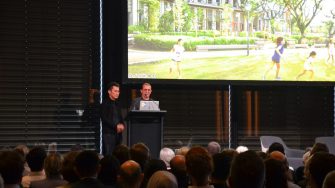WOHA directors show Sydney how green and lush high-rise living can be
The 2023 Donald K. Turner UTZON lecture was delivered by Richard Hassell and Wong Mun Summ, co-founders and directors of Singapore studio WOHA.
The 2023 Donald K. Turner UTZON lecture was delivered by Richard Hassell and Wong Mun Summ, co-founders and directors of Singapore studio WOHA.

On a rainy Monday evening, Sydney’s architecture community gathered to hear distinguished Singaporean architects Richard Hassell and Wong Mun Summ deliver the 2023 Donald K. Turner UTZON lecture at the Hyatt Regency in Sydney CBD.
Richard Hassell and Wong Mun Summ, co-directors and founders of Singaporean studio WOHA, are award winners across architectural, urban design and sustainability fields.
Utilising a systems thinking approach, WOHA has produced numerous large-scale built environment projects that serve as creative solutions for 21st century problems like climate change, population growth and rapid urbanisation.
Hassell and Mun Summ showcased a selection of WOHA’s built and envisioned projects, demonstrating how high density living and net zero performance can strengthen community, create delightful spaces to spend time in, enhance amenity for those who live there – and even increase the biodiversity of local flora and fauna better than a conventional park can.
WOHA’s urban solutions are dense in terms of population but lush with greenery. Their goal is to create a village atmosphere in each building, where people living in the space benefit by experiencing interconnectedness and develop a stewardship towards nature.
WOHA’s creative solutions inspire the architecture community to reconsider what we expect from high density living and our built environment.
Watch the full 2023 Donald K. Turner UTZON lecture with WOHA directors on YouTube:
For these very reasons detailed above, Hassell and Mun Summ were appointed Seidler Chairs in the practice of architecture at UNSW Arts, Design & Architecture – a role graciously funded by Dr. Penelope Seidler AO.
As part of their Chair responsibilities, Hassell and Mun Summ ran a summer intensive studio for architecture, interior and landscape students from UNSW Arts, Design & Architecture.
The studio brief challenged students to work together to envision a new high-density community north of UNSW, along the edge of the Randwick Racecourse. Students not only had to work together to create a coherent vision of buildings, spaces and landscape, but also had to adapt WOHA’s design principles and philosophy to their own individual building proposal as part of that vision, and to prove that their building met the ambitious target of net zero carbon across its whole lifecycle.
With thanks to Dr. Penelope Seidler AO, UNSW Built Environment students took advantage of the opportunity to learn from distinguished architects of global notoriety – making the next generation of architects better equipped to solve 21st Century problems.